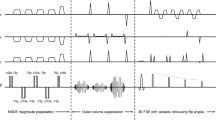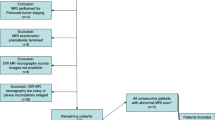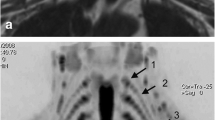Abstract
Objective
To compare 1.5-T and 3-T magnetic resonance (MR) imaging of the brachial plexus.
Materials and Methods
Institutional review board approval and informed consent were obtained from 30 healthy volunteers and 30 consecutive patients with brachial plexus disturbances. MR was prospectively performed with comparable sequence parameters and coils with a 1.5-T and a 3-T system. Imaging protocols at both field strengths included T1-weighted turbo spin-echo (tSE) sequences and T2-weighed turbo spin-echo (tSE) sequences with fat saturation. The signal-to-noise ratio (SNR) and contrast-to-noise ratio (CNR) between muscle and nerve were calculated for both field strengths. The visibility of brachial plexus nerve at various anatomic levels (roots, interscalene area, costoclavicular space, and axillary level) was analyzed with a four-point grading scale by two radiologists. MR imaging diagnoses and pathological findings were also compared qualitatively.
Results
SNR and CNRs were significantly higher on 3-T MR images than on 1.5-T MR images (Friedman test) for all sequences. Nerve visibility was significantly better on 3-T MR images than on 1.5-T MR images (paired sign test). Pathological findings (n = 30/30) were seen equally well with both field strengths. MR imaging diagnoses did not differ for the 1.5- and 3-T protocols.
Conclusions
High-quality MR images of the brachial plexus can be obtained with 3-T MR imaging by using sequences similar to those used at 1.5-T MR imaging. In patients and healthy volunteers, the visibility of nerve trunks and cords at 3-T MR imaging appears to be superior to that at 1.5-T MR imaging.




Similar content being viewed by others
References
Willinek WA, Born M, Simon B, et al. Time-of-flight MR angiography: comparison of 3.0-T imaging and 1.5-T imaging—initial experience. Radiology. 2003;229:913–20.
Nakada T. Clinical experience on 3.0 T systems in Niigata 1996 to 2002. Invest Radiol. 2002;38:377–84.
Briellmann RS, Pell GS, Wellard RM, et al. MR imaging of epilepsy: state of the art at 1.5 T and potential of 3 T. Epileptic Disord. 2003;5:3–20.
Al Kwifi O, Emery DJ, Wilman AH. Vessel contrast at three Tesla in time-of-flight magnetic resonance angiography of the intracranial and carotid arteries. Magn Reson Imaging. 2002;20:181–7.
Thomas SD, Al Kwifi O, Emery DJ, et al. Application of magnetization transfer at 3.0 T in three-dimensional time-of-flight magnetic resonance angiography of the intracranial arteries. J Magn Reson Imaging. 2002;15:479–83.
Nobauer-Humann IM, Ba-Ssalamah A, Mlynarik V, et al. Magnetic resonance imaging contrast enhancement of brain tumors at 3 Tesla versus 1.5 Tesla. Invest Radiol. 2002;37:114–9.
Kim S, Choi JY, Huh YM, et al. Role of magnetic resonance imaging in entrapment and compressive neuropathy: what, where, and how to see the peripheral nerves on the musculoskeletal magnetic resonance image: part 2. Upper extremity. Eur Radiol. 2007;17:509–22.
Todd M, Shah GV, Mukherji SK. MR imaging of brachial plexus. Top Magn Reson Imaging. 2004;15:113–25.
van Es HW. MRI of the brachial plexus. Eur Radiol. 2001;11:325–36.
Vargas MI, Viallon M, Nguyen D, et al. Diffusion tensor imaging (DTI) and tractography of the brachial plexus: feasibility and initial experience in neoplastic conditions. Neuroradiology. 2010;52:237–45.
Bowen B, Pattany P, Saraf-Lavi E, et al. The brachial plexus: normal anatomy, pathology, and MR imaging. Neuroimag Clin N Am. 2004;14:59–85.
Edelstein WA, Glover GH, Hardy CJ, et al. The intrinsic signal-to-noise ratio in NMR imaging. Magn Reson Med. 1986;3:604–18.
Femlee JP, Bernstein MA, Huston J. Analysis of RF heating at 3.0 T. ISMRM 2002; p. 2002.
Lin C, Bernstein M, Huston J, et al. In-vivo and in-vitro measurements of T1 relaxation at 3.0 T. In: Proc 9th Meeting ISMRM 2001; p. 1391.
Wansapura JP, Holland SK, Dunn RS, et al. NMR relaxation times in human brain at 3.0 T. J Magn Reson Imaging. 1999;9:531–8.
Saupe N, Prussmann P, Luechinger R, et al. MR imaging of the wrist: comparison between 1.5- and 3-T MR imaging—preliminary experience. Radiology. 2005;234:256–64.
Hennig J, Scheffler K. Hyperechoes. Magn Reson Med. 2001;46:6–12. 644.
Kangarlu ARP. Biological effects and health implications in magnetic resonance imaging. Concepts Magn Reson. 2000;12:321–59.
Farooki S, Ashman CJ, Yu JS, et al. In vivo high-resolution MR imaging of the carpal tunnel at 8.0 Tesla. Skeletal Radiol. 2002;31:445–50.
Viallon M, Vargas MI, Jlassi H, et al. High-resolution and functional magnetic resonance imaging of the brachial plexus using an isotropic 3D T2 STIR (Short Term Inversion Recovery) SPACE sequence and diffusion tensor imaging. Eur Radiol. 2008;18:1018–23.
Author information
Authors and Affiliations
Corresponding author
Additional information
The authors declare that there are no conflicts of interest.
Rights and permissions
About this article
Cite this article
Tagliafico, A., Succio, G., Emanuele Neumaier, C. et al. MR imaging of the brachial plexus: comparison between 1.5-T and 3-T MR imaging: preliminary experience. Skeletal Radiol 40, 717–724 (2011). https://doi.org/10.1007/s00256-010-1050-x
Received:
Revised:
Accepted:
Published:
Issue Date:
DOI: https://doi.org/10.1007/s00256-010-1050-x




